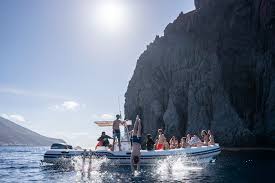Italy: The “lighthouse of the Mediterranean”

Rome: Nicknamed the “lighthouse of the Mediterranean” for its steady towering glow, Stromboli is one of seven volcanic islands that make up the Aeolian archipelago off Sicily’s northern coast.
Barely a quarter the size of Manhattan, and measuring just 3,031 feet above sea level, it reigns as one of the world’s most active volcanoes, having spewed fountains of lava almost continuously for nearly 2,500 years.
Important to volcanology, Stromboli and its neighboring islands were named a UNESCO World Heritage sitein 2000. Every summer, boatloads of visitors journey here for the gleaming black-sand beaches, and as many as 500 travelers trek to the island’s summit each sunset to view the lava fireworks against the night sky. Last July, before most guided tours set off for the four-hour ascent, an unusually violent paroxysmal eruption launched a column of gas three miles high. Searing pebbles and ash rained down the southwestern slope, igniting brush fires. Rescue boats evacuated trapped locals and visitors, but one hiker died, and several others were injured.
Stromboli’s volcano is in a constant state of mild activity, punctuated by occasional larger, more violent eruptions. Following explosions in the summer of 2019, Italy’s Civil Protection Agency deemed it unstable and prohibited access above 950 feet.
Weeks later, on August 28, another massive explosion initiated a pyroclastic flow down the Sciara del Fuoco (“Stream of Fire”), a steep channel where molten lava gushes from the summit craters to the sea. It caused an avalanche of gas and rock fragments and triggered a small tsunami. Italy’s Civil Protection Agency pronounced the volcano unstable, and access above 950 feet—about one-third of Stromboli’s elevation—was prohibited.
The safety interventions that were taken following Stromboli’s deadly eruptions underscore the fact that volcano tourism is inherently a risky business. This became tragically evident with the 2019 eruption at Whakaari/White Island, a small volcanic isle in New Zealand’s Bay of Plenty. A number of tourists were on the island when a series of violent blasts rang out; several tourists were right next to the volcano’s active vent, and multiple deaths were recorded. Although the eruption itself was not extraordinary, the proximity of tourists on the island that day resulted in what one volcanologist described as “probably the actual worst-case scenario.”
It is never advisable for tourists to put themselves in harm’s way, so I set out in November to see whether a visit at Stromboli without the panoramic mountaintop views and above-the clouds crater close-ups would satisfy.
“Volcano tours have decreased significantly since the summer eruptions,” says Beatrice Fassi of local tour company Magmatrek. “If tourism continues here, we will need to reinvent.”
At dusk, we walk swiftly up a narrow road through San Vicenzo, San Bartolo, and Piscità—three communities on the island’s northern edge where most inhabitants live. When a violent eruption killed six people in 1930, Stromboli’s population dwindled from about 5,000 to fewer than 500.
We hope to reach the route skirting the Sciara del Fuoco before dark. Stromboli’s white-washed homes, festooned with colorful bougainvillea, trumpet vines, and plumbago, brighten the dimming day. The occasional headlights of a motorscooter and three-wheeled mini-trucks flash by, but there are no street lights or cars on Stromboli. At Punta Labronzo, with its head-tilting views of Stromboli’s fiery fountains, I slip my headlamp on and continue up the mountain to meet the island’s legendary guide and volcano historian, Mario (Zazà) Zaia.
Mario Zaia, one of the island’s most experienced guides, leads a group of hikers up Stromboli volcano.
The path turns into a series of ascending switchbacks. They were paved with slabs of volcanic stone in 1951, the year after the release of Roberto Rossellini’s film set here, Stromboli, starring Ingrid Bergman. About every 15 minutes, the volcano belches, giving off a thunderous roar and spewing flashes of glowing red magma. Alone in this unfamiliar world, I feel surprisingly calm.
I reach the lookout in 90 minutes and join a dozen volcano enthusiasts taking in rumbles and leaping flames. Suddenly, a bearded silhouette with a pair of walking sticks and a dog at his heels zips past. I call out “Zazà!” We descend the mountain together. “We’re living on a bomb,” he says.
“Does that frighten you?” I ask. On the contrary, Zaia says he feels infinite awe for the persistent force that propelled this stratovolcano to rise from the floor of the Tyrrhenian Sea and build, eruption after eruption, the cone we see today.
In safe conditions, it takes three to four hours to walk to Stromboli’s summit. Although the peak is currently closed, hikers can still take guided tours around the lower half of the volcano.
Hiking guide Mario Zaia has lived on Stromboli for over 30 years. He makes an annual solo trek up the volcano. “It’s me and the volcano, nobody else,” he says. “The volcano is a mountain that reveals the unknown world of the earth’s depth.”
In safe conditions, Zaia may lead groups up and down the summit twice a day, but he says he’s never tired or bored. Each trek inspires and uplifts him while conveying a splendid precariousness. Discover other communities in the shadows of volcanoes.
Today’s Strombolanis are deeply committed to making island life sustainable for future generations. Vincenzo Cusolito began planting Malvasia grape vineyards four years ago. In the 18th century, Stromboli’s inhabitants farmed the volcano’s terraced slopes, but, in 1880, a parasitic phylloxera outbreak attacked the grapevines and destroyed the agricultural culture. Some residents turned to the sea for their living; others emigrated to Australia. But next September, as part of an agrotourism venture with his three sons, Cusolito plans to host vino tastings and have the public assist with his annual grape harvest. The Cusolitos also donate their time to the co-operative Attiva Stromboli, a non-profit organization resuscitating olive trees abandoned by earlier islanders.
By day, Salvatore Russo works construction. At night, in a spacious atelier next to his home, he sculpts the dense basalt stone the volcano hurls. Visitors to his studio, popular on tour itineraries, can browse his works and watch him carve.
Stromboli’s fishermen cast nets late at night from small wooden boats, returning at dawn to sell their catch along the beach. Chef Frank Utano, a former fisherman, hand-picks seafood every morning for his restaurant, Ristorante da Zurro, located across from the harbor. He tosses anchovies, locally grown garlic, cherry tomatoes, and hot chili peppers onto fresh pasta for his signature dish, spaghetti alla Stromboliana. His restaurant’s creative appetizers, heart-stopping views, and friendly ambience have garnered a loyal clientele among summer visitors.
On my last day in Stromboli, Magmatrek’s youngest guide, Manuel Oliva, leads me on a nature hike overlooking the three northern villages. Born and raised here, Oliva plans to stay. On a plot near the coast, he is planting mango and avocado trees, an initiative that introduces new fruit sources and prevents erosion.
When we arrive at the 950-foot belvedere, Oliva remains for security duty, and I descend the mountain on the switchback route from nights before. In daylight, I see what had been concealed by the dark. Prickly pear cactus and gnarled olive trees cling to the slope. The cobalt sea shimmers below. Like Zaia, I’m energized by the experience of hiking this volcano again. But I realize I don’t need to ascend Stromboli’s summit to find satisfaction. Sometimes a volcano is best viewed from below, with one’s eyes to the skies in gratitude.
The Stromboli’s jet-like bursts of lava are so distinctive that scientists use the phrase “strombolian” to characterize other active volcanoes around the world.
The day after I left Stromboli, the alert code was reduced from orange to yellow, according to Maurizio Ripepe, a professor of geophysics and physical volcanology at the University of Florence and researcher for the Italian Civil Defense in volcano hazard assessment.
“This means the volcano is progressively coming back to normal,” he tells me. “However, explosive activity remains quite high and requires attention. At the moment, Civil Defense is still considering which part and which elevation tourists may visit.” Still, last summer’s explosions suggest that the last 60 years were a period of relatively low activity and that the volcano could be more active in the future, as it was until 1959. Says Ripepe, “We will need to rethink how we use the island and how to make visiting the volcano pleasant and safe.”





